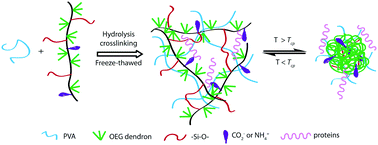当前位置:
X-MOL 学术
›
J. Mater. Chem. B
›
论文详情
Our official English website, www.x-mol.net, welcomes your
feedback! (Note: you will need to create a separate account there.)
Thermoresponsive double network cryogels from dendronized copolymers showing tunable encapsulation and release of proteins†
Journal of Materials Chemistry B ( IF 6.1 ) Pub Date : 2018-02-19 00:00:00 , DOI: 10.1039/c7tb03352d Xiaoqing Feng 1, 2, 3 , Jie Liu 1, 2, 3 , Gang Xu 1, 2, 3 , Xiacong Zhang 1, 2, 3 , Xinyan Su 1, 2, 3 , Wen Li 1, 2, 3, 4, 5 , Afang Zhang 1, 2, 3
Journal of Materials Chemistry B ( IF 6.1 ) Pub Date : 2018-02-19 00:00:00 , DOI: 10.1039/c7tb03352d Xiaoqing Feng 1, 2, 3 , Jie Liu 1, 2, 3 , Gang Xu 1, 2, 3 , Xiacong Zhang 1, 2, 3 , Xinyan Su 1, 2, 3 , Wen Li 1, 2, 3, 4, 5 , Afang Zhang 1, 2, 3
Affiliation

|
A series of double-network cryogels (DNCs) were prepared from oligoethylene glycol (OEG)-based dendronized copolymers as the first network and polyvinyl alcohol (PVA) as the second network. The dendronized copolymers were composed of dendritic OEG units, as well as triethoxysilyl, amine or carboxyl groups. The dendritic OEGs ensured characteristic thermoresponsiveness and triethoxysilyl groups were for crosslinking, while amino and carboxyl groups were designed to provide charged species for specifically interacting with proteins. PVA behaves as a mutual support which ensures the stability and mechanical properties of the cryogels. These DNCs exhibited good thermoresponsiveness and biocompatibility. Upon increasing the temperature above their cloud points (Tcps), the cryogels became dehydrated with enhanced hydrophobicity, and thus their porous structures shrank. This property was utilized to mediate encapsulation and release of proteins. The loading and release efficiencies of different proteins were found to be dominated by hydrophilic to hydrophobic transitions of the first network, and at the same time, by the properties of proteins. At room temperature, the cryogel could efficiently capture model proteins, while above Tcps, more than 80% of lysozyme could be released in 24 h with enzyme activity remaining unchanged. These series of smart cryogels based on thermoresponsive dendronized copolymers may provide promising applications for the reversible capture of enzymes or proteins.
中文翻译:

来自树枝状共聚物的热响应性双网络冰晶,显示出可调节的蛋白质包封和释放†
由基于低聚乙二醇(OEG)的树状共聚物作为第一个网络,并使用聚乙烯醇(PVA)作为第二个网络,制备了一系列双网络冰晶(DNC)。树枝状共聚物由树枝状OEG单元以及三乙氧基甲硅烷基,胺或羧基组成。树突状OEG确保了特征性的热响应性,并且三乙氧基甲硅烷基用于交联,而氨基和羧基则设计用于提供带电荷的物质以与蛋白质特异性相互作用。PVA充当相互支持的角色,可确保冰晶玻璃的稳定性和机械性能。这些DNC表现出良好的热响应性和生物相容性。当温度升高到其浊点以上(T cps),冰晶凝胶脱水后疏水性增强,因此其多孔结构收缩。利用该性质来介导蛋白质的包封和释放。发现不同蛋白质的负载和释放效率受第一个网络的亲水性至疏水性转变的支配,同时受蛋白质特性的支配。在室温下,冷冻凝胶可以有效地捕获模型蛋白,而在T cp s以上时,24小时内可以释放80%以上的溶菌酶,而酶的活性保持不变。这些基于热响应性树突化共聚物的智能冷冻凝胶系列可为酶或蛋白质的可逆捕获提供有希望的应用。
更新日期:2018-02-19
中文翻译:

来自树枝状共聚物的热响应性双网络冰晶,显示出可调节的蛋白质包封和释放†
由基于低聚乙二醇(OEG)的树状共聚物作为第一个网络,并使用聚乙烯醇(PVA)作为第二个网络,制备了一系列双网络冰晶(DNC)。树枝状共聚物由树枝状OEG单元以及三乙氧基甲硅烷基,胺或羧基组成。树突状OEG确保了特征性的热响应性,并且三乙氧基甲硅烷基用于交联,而氨基和羧基则设计用于提供带电荷的物质以与蛋白质特异性相互作用。PVA充当相互支持的角色,可确保冰晶玻璃的稳定性和机械性能。这些DNC表现出良好的热响应性和生物相容性。当温度升高到其浊点以上(T cps),冰晶凝胶脱水后疏水性增强,因此其多孔结构收缩。利用该性质来介导蛋白质的包封和释放。发现不同蛋白质的负载和释放效率受第一个网络的亲水性至疏水性转变的支配,同时受蛋白质特性的支配。在室温下,冷冻凝胶可以有效地捕获模型蛋白,而在T cp s以上时,24小时内可以释放80%以上的溶菌酶,而酶的活性保持不变。这些基于热响应性树突化共聚物的智能冷冻凝胶系列可为酶或蛋白质的可逆捕获提供有希望的应用。











































 京公网安备 11010802027423号
京公网安备 11010802027423号